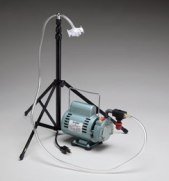Find a Mold Specialist Now
Click or Call, Toll-Free 24/7
Test for Mold
Review of Mold Tests
There are several ways how to test for mold. You can buy test kits to use yourself at home, or you can have a professional come in and test your home for you. We really recommend you have a professional come in and test your home for mold, and we’ll explain why in a moment. First, though, we’ll tell you about the different types of tests for mold.
If you’re going to conduct your own home tests for mold, it’s usually recommended that you do both surface tests and air sampling tests. You’ll need to do tests in each room that might be affected by mold. That means rooms where you see mold growing on the wall or floor or some other surface, rooms with a musty odor, or rooms in which you experience symptoms of mold irritation, like a stuffy nose, sneezing, coughing, watery eyes, etc. You can choose to buy test kits that contain several surface tests and several air sampling tests so that you can test your whole house. You may wish to buy two test kits, though, so you can test your home again after treating your home for mold to make sure the problem has been resolved.
Surface Tests – How to test for mold with swabs
Surface tests are mostly used when you find mold growing on some surface and want to find out what kind of mold it is and whether or not it’s a toxic form of mold. You wipe a test swab through the mold, then wipe the swab on a sheet of test film and squeeze on some activating liquid. Store the test film in a warm place and wait for a few days, maybe as long as a week.
Mold colonies will grow to look like small dots and the more colonies that grow, the bigger your mold problem. Different types of mold will grow in different colors and your test kit will come with instructions that tell you how to test for mold and what the different colors mean.
You can look around for areas of mold growing on various surfaces in your home, of course, but if you call in a professional tester, he or she will know all the most likely places to look and just what to look for.
Air Sampling Tests – How to test for mold by sampling the air

Air sampling tests take samples of mold from the air. If you suspect you may have mold in an area but can’t locate a surface on which it is growing, such as when a room has a characteristically musty smell, you should try an air sampling test. You may also want to do an air sampling test in a room in which you did surface testing, though, just to see if anything else is growing in there.
To perform an air sampling test, typically you squeeze some testing solution into a plastic dish, like a Petri dish, then expose it to the air in the room you want to test for an hour or so. Next, store the dish at room temperature in a dimly lit area for several days, then check it. Different types of mold will grow in different colors and your test kit will come with instructions that tell you how to test for mold and what the different colors mean. Some air sampling tests also tell you if you have bacteria or fungi in the air.
You can guess which rooms to test, but you can also call a professional who will know exactly where to test.
When to Call a Professional Mold Tester
If you’re a do-it-yourself kind of homeowner, you may prefer to test your home for mold yourself. Under some circumstances, that will probably be sufficient provided you follow all directions on the test kit carefully. Under some circumstances, though, we recommend calling a professional mold tester.
It’s a good idea to call a professional mold tester if:
- Your homeowner’s insurance will cover the cost, thereby making it more affordable to have a professional do the test than to do it yourself (insurance companies will not pay for home tests you perform yourself).
- You conduct a home mold test and it indicates no mold is present, but you smell a musty odor which typically indicates the presence of mold or continue to experience health problems typical of those related to exposure to mold. Home tests are not as reliable as professional tests for mold.
- You’re not sure you’ve located all the mold in your home.
- You want to know what kind of mold is growing in your home so that you can determine the best type of biocide to use to remove it, or so you can let your doctor know what you’ve been exposed to in case it affects the best treatment for your mold exposure symptoms.
Follow this link to get a list of qualified professionals that can test for mold in your area.
Whether or not you are aware of a mold problem in your home or building, air testing should be performed as a precautionary measure. Leave the investigating to the professionals where toxic mold detection is their specialty. Disturbance of a mold infested area can lead to a release of spores into the air that can cause serious illnesses.
Return From Test For Mold To Our Main Toxic Mold Test Page
Black Mold Health Symptoms Home Page





